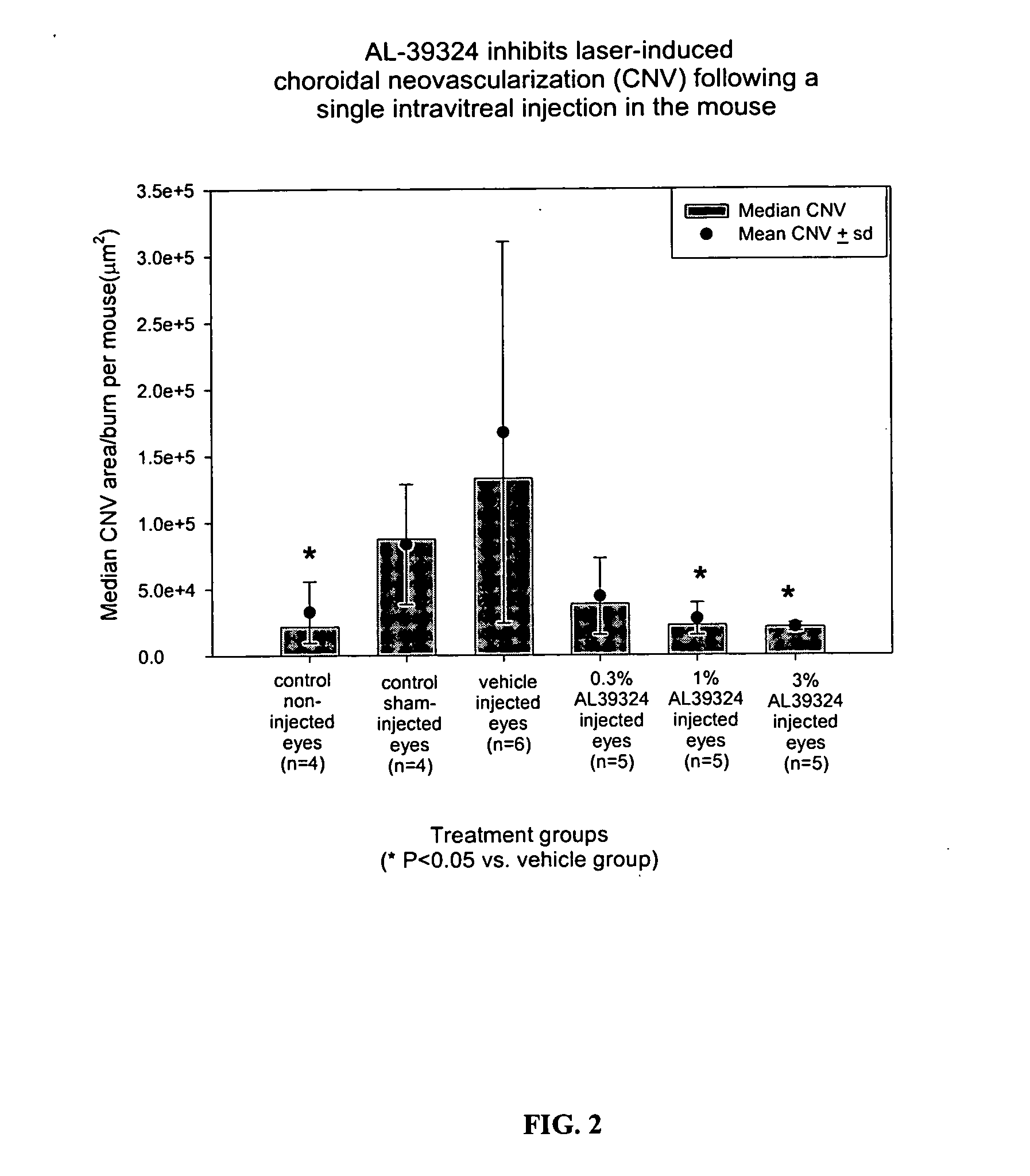Methods for treating ocular angiogenesis, retinal edema, retinal ischemia, and diabetic retinopathy using selective RTK inhibitors
a technology of ocular angiogenesis and rtk inhibitors, applied in the direction of biocide, drug composition, extracellular fluid disorder, etc., can solve the problems of few treatment strategies, few palliative treatments, and tissue edema, and achieve high potency and efficacy prevention
- Summary
- Abstract
- Description
- Claims
- Application Information
AI Technical Summary
Benefits of technology
Problems solved by technology
Method used
Image
Examples
example 1
Prevention of Preretinal Neovascularization Following Intravitreal Delivery of the Receptor Kinase Tyrosine Inhibitor (RTKi), AL-39324, in the Rat Model of Oxygen-Induced Retinopathy
[0152] METHODS: Pregnant Sprague-Dawley rats were received at 14 days gestation and subsequently gave birth on Day 22±1 of gestation. Immediately following parturition, pups were pooled and randomized into separate litters (n=17 pups / litter), placed into separate shoebox cages inside oxygen delivery chamber, and subjected to an oxygen-exposure profile from Day 0-14 postpartum. Litters were then placed into room air from Day 14 / 0 through Day 14 / 6 (days 14-20 postpartum). Additionally on Day 14 / 0, each pup was randomly assigned as an oxygen-exposed control or into various treatment groups. For those randomized into an injection treatment group: one eye received a 5 μl intravitreal injection of 0.1%, 0.3%, 0.6%, or 1% AL-39324 and the contralateral eye received a 5 μl intravitreal injection of vehicle. At ...
example 2
Systemic Administration of AL-39324 (RTKi) Potently Prevents Preretinal Neovascularization in the Rat OIR Model
[0155] METHODS: Pregnant Sprague-Dawley rats were received at 14 days gestation and subsequently gave birth on Day 22±1 of gestation. Immediately following parturition, pups were pooled and randomized into separate litters (n=17 pups / litter), placed into separate shoebox cages inside oxygen delivery chamber, and subjected to an oxygen-exposure profile from Day 0 to Day 14 postpartum. Litters were then placed into room air from Day 14 / 0 through Day 14 / 6 (days 14-20 postpartum). Additionally on Day 14 / 0, each pup was randomly assigned as oxygen-exposed controls, vehicle treated, or drug-treated at 1.5, 5, 10 mg / kg, p.o., BID. At Day 14 / 6 (20 days postpartum), all animals in both studies were euthanized and retina whole mounts were prepared as described in Example 1 above.
[0156] RESULTS: Systemic administration of the RTKi, AL-39324, provided potent efficacy in the rat OIR m...
example 3
Prevention of Laser-Induced Choroidal Neovascularization (CNV) Following a Intravitreal Delivery of the Receptor Kinase Tyrosine Inhibitor (RTKi), AL-39324, in the Mouse
[0157] Methods. CNV was generated by laser-induced rupture of Bruch's membrane. Briefly, 4 to 5 week old male C57BL / 6J mice were anesthetized using intraperitoneal administration of ketamine hydrochloride (100 mg / kg) and xylazine (5 mg / kg) and the pupils of both eyes dilated with topical ocular instillation of 1% tropicamide and 2.5% Mydfin®. One drop of topical cellulose (Gonioscopic®) was used to lubricate the cornea. A hand-held cover slip was applied to the cornea and used as a contact lens to aid visualization of the fundus. Three to four retinal burns were placed in randomly assigned eye (right or left eye for each mouse) using the Alcon 532 nm EyeLite laser with a slit 5 lamp delivery system. The laser burns were used to generate a rupture in Bruch's membrane, which was indicated ophthalmoscopically by the fo...
PUM
| Property | Measurement | Unit |
|---|---|---|
| vascular permeability | aaaaa | aaaaa |
| retinal vascular permeability | aaaaa | aaaaa |
| concentration | aaaaa | aaaaa |
Abstract
Description
Claims
Application Information
 Login to View More
Login to View More - R&D
- Intellectual Property
- Life Sciences
- Materials
- Tech Scout
- Unparalleled Data Quality
- Higher Quality Content
- 60% Fewer Hallucinations
Browse by: Latest US Patents, China's latest patents, Technical Efficacy Thesaurus, Application Domain, Technology Topic, Popular Technical Reports.
© 2025 PatSnap. All rights reserved.Legal|Privacy policy|Modern Slavery Act Transparency Statement|Sitemap|About US| Contact US: help@patsnap.com



